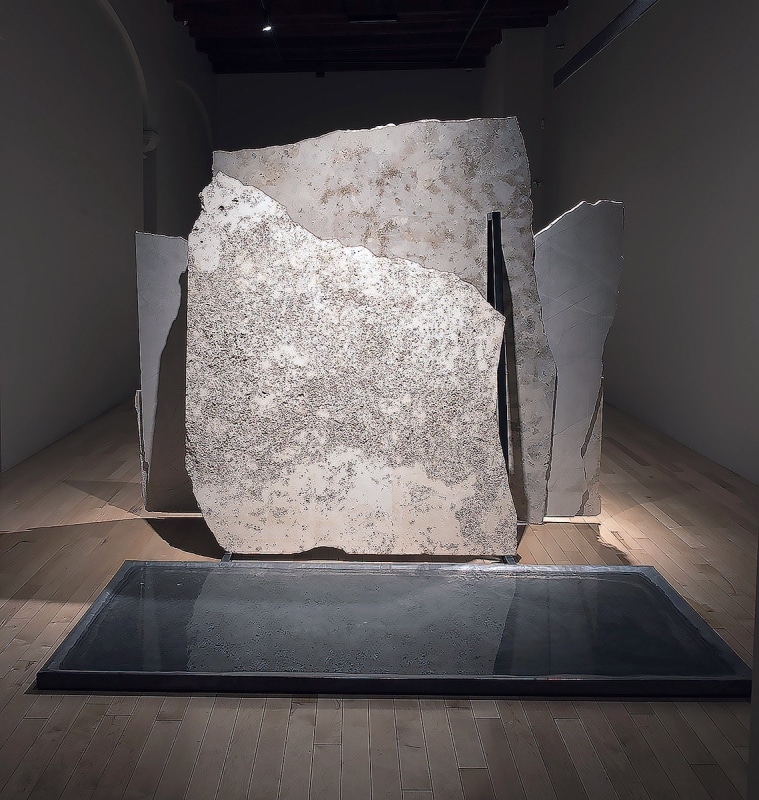Perla Krauze
Museo Amparo
The secret history of rocks was the path chosen by visual artist Perla Krauze (Mexico City, 1953) to express her closeness to, her findings around, and her reminiscences concerning stony elements found in quarries, mountains, and salt mines located east of the Sierra Madre Oriental in the Mexican state of Puebla, next to the Mexican plateau’s volcanic axis.
The selection of works and art actions in sculpture, painting, installation, video, and a number of on-site interventions reveals Krauze’s great passion for the land and the traces that human beings have left on it across the ages. The proposal is a visual and kinesthetic itinerary that, by means of rocks, monoliths, pottery items, salts, and sands, materialized in the present via the memory of the remote past of the territory of Puebla, which thousands of years ago was entirely undersea.
Josefa Ortega’s curatorship was key to reveal not only the dialogical capacity of the works on exhibit, but also the spatiality and the sensorial games with lights, shadows, sounds, and images that this solo exhibition, titled Materia lítica (Lithic Matter), brings forth in the galleries of Puebla’s Museo Amparo.
Krauze’s work moves forward with these trajectories, encounters, and accumulations as its guiding principle, without strictly adhering to any one traditional technique. In other words, many of her works oscillate between sculpture and painting, making it possible for us as viewers to become participants in her process and her amazement at the colors, shapes, and textures of every work included in this exhibition.
Both religious thinking and primitive reason tend to establish the origin of everything that is present in the universe at the point in which the cosmos emerges from the primordial chaos. The chaos present in Perla Krauze’s is not a mere disorder, but a free proposal that is not arranged in a linear or a closed manner and instead remains in an undefined state that makes many readings possible.
The exhibition presents us with the following question: How is it possible for tracks and traces to have remained on the rocks for so many millennia? The undefined aspect of natural shapes and the randomness of the “supposed” domestication or malleability of the rocks. A vestige of that instant when chaos becomes cosmos.
The diversity of the works on exhibit will allow us to discern an archive or atlas of the processes of rock extraction and molding, as well as their residues. In this way, we come to realize the way in which the artist redirects her gaze towards new points of view that multiply the possibilities of the visual on the basis of a love for the land.
Cabinet and Discoveries. In the first gallery, we find an archive-like display of the main elements used by the artist in this exhibition. Each of the stones used during this period corresponds to a segment of the memory and of the eras that gave shape to regions like the Zapotitlán salt mines, near the Tehuacán-Cuicatlán cactus preserve, an emblematic site for the production of the mineral since pre-Hispanic times. Perla Krauze included a series of cubes of local rocks, 10 cm per side, as well as simple allusions to the Puebla pottery style known as talavera.
Water and Stone. Water is the natural element permanently present in the second gallery, which starts with a video presenting the way in which water (by means of pressure-forced jets) molds, cuts, and polishes rocks or sheets of raw marble in industrial or artisanal quarries. Rhythmic sounds and motions accompanying images of these processes are documented in a simple and poetic way.
Through these exercises of material memory, Mexican artist Perla Krauze registers time and space by putting her emotions on display by means of a variety of processes by which human beings have been surrounded by rocks, sand, and salts since the beginning of time. This series of art actions invite viewers to observe matter’s evolution and state changes, from gas to liquid and from liquid to solid, always keeping in mind that chaos is neither solid, liquid, nor gas. Everything is in process of transmutation.

